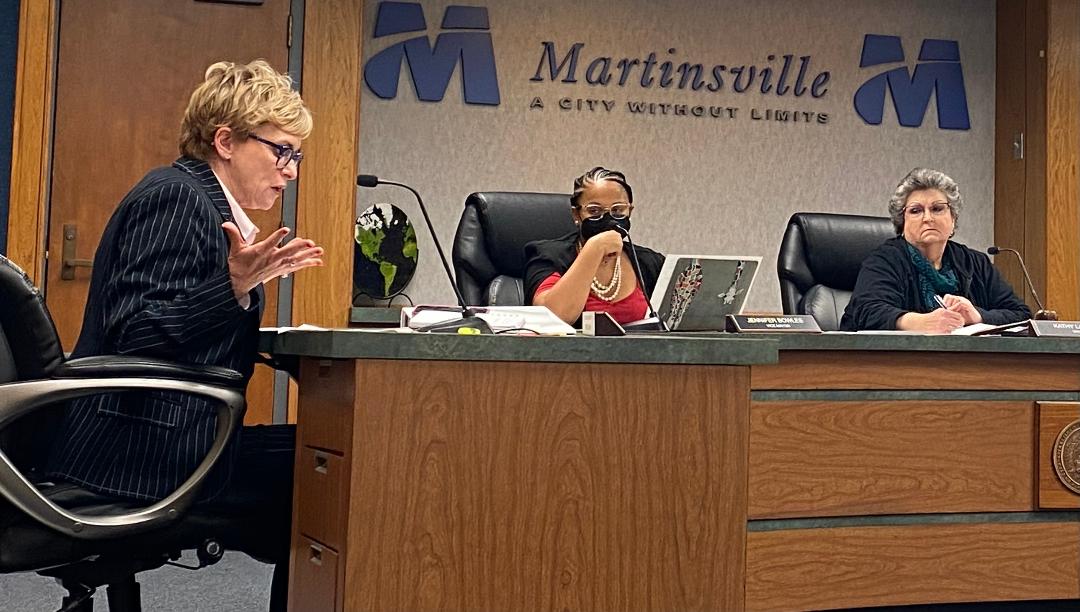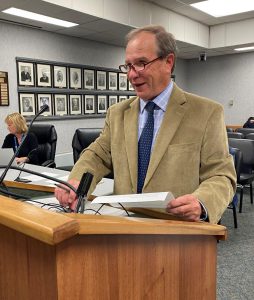
By Callie Hietala
A discussion about the proposed uses of federal American Rescue Plan Act (ARPA) funding grew heated during Tuesday’s regular meeting of the Martinsville City Council. A tense back-and-forth between several council members occurred when council member Tammy Pearson expressed reservations about the method by which a list of possible projects to be funded through the pandemic relief money was compiled. Pearson called for a process with more public input and discussion.
Her comments came after a presentation by City Manager Leon Towarnicki discussed a proposed project list that was created by city staff, for the $15.5 million in ARPA funding allocated to the city. He explained that half the funds were received in June 2021 and noted that the remainder is expected in June of this year. The money, he said, must be committed by the end of 2024 and spent by the end of 2026.
The project list, he said, included both previously discussed projects and others that the city would not normally have been able to fund in its normal budgeting process.
Proposed projects include $1,850,000 for improvements and renovations to bathrooms, seating, and concessions at Hooker Field; $804,070 for the Summit View Water Line Project; $200,00 for the establishment of city-wide historic districts; another $200,000 for various stormwater repairs; and $500,000 each for blighted property demolition, upgrades to the city’s municipal building, citywide park upgrades, and affordable housing.
Towarnicki said $1,918,073 was put toward projects that are already completed or committed.
The list also included a proposed $50,000 for Piedmont Arts’ capital campaign, and $4.5 million for uptown revitalization, which was the largest expense presented.
After a number of conversations with Uptown Partnership Director Kathy Deacon, Towarnicki said city staff decided to put a great deal of emphasis into the revitalization effort. He suggested that some of the funds could even be used to acquire and rehabilitate some of the uptown’s long-vacant buildings to help them find new life.
In addition to the projects identified by staff, Towarnicki said up to $10 million can be used in the budget to make up for lost revenue. “I’m certainly not advocating that we do that,” he said, clarifying that he was merely pointing out the possibility. The list presented to the board proposed that $4 million be directed toward lost revenue.
All told, Towarnicki said the list compiled by staff exceeded the amount of ARPA funding the city expects to receive by nearly $500,000. However, he told council that several of the projects, when put out to bid, could cost less than initially estimated, thus bringing the actual expenses closer to the amount of funding allocated.
As council began discussion of the proposed projects, Pearson asked why more funding was not being directed toward city infrastructure, because it was her understanding that many of the city’s pipes, most of which Towarnicki said were put in in the 50s and 60s—are far past their expected lifespan.
“I think this could be an opportunity to be proactive instead of reactive,” she said.
“I just know with the reversion discussions, we’ve continuously said that our infrastructure is crumbling,” Pearson continued, “we said if we were to revert, we’d have more money to focus on that crumbling infrastructure. Why wouldn’t we use this opportunity to use some of the money to address that?”

Towarnicki responded that, while such a project was possible, a detailed and extensive study would be needed to accomplish it and, to his knowledge, a “fair amount” of the more problematic pipelines had been replaced. He said he was unaware of current areas where significant breaks indicated a line could be failing.
A water line, “if it’s taken care of and maintained and the pressure’s not excessive, it can just last and last,” he said.
City Attorney and Assistant City Manager Eric Monday said the city was more likely to find other funding sources for infrastructure than the projects included on the ARPA funding list. “One of the reasons the staff came up with this list is that a lot of the items on here don’t get advantageous financing, they’re not good grant applicants, so that’s why we’ve put them off for so long.”
Vice Mayor Jennifer Bowles asked Pearson what she would remove from the list and how much she would allocate to infrastructure instead.
“I’m glad you asked,” Pearson said, adding that while she did not yet have enough expertise to directly address Bowles’ question, she researched processes used by officials in other cities and towns, particularly those comparable to Martinsville, in determining how to allocate their ARPA funding.
The localities she examined engaged with residents via surveys and meetings to gauge the needs and desires of the community before generating a list of proposed projects. Pearson said she would like to see a similar process take place in Martinsville.
Additionally, she would like to solicit feedback from various subject matter experts, including department heads in the city, before considering overall funding options.
Bowles said Martinsville residents recently had the opportunity to participate in a survey about the city’s Uptown, which was similar to what Pearson was describing.
Additionally, Bowles said, “I’m sure Leon and Eric already consulted with the department heads about what they feel should be the priorities. But like you said, if you, who are on council, don’t have a handle on the subject matter, do you feel like our citizens would have a handle on priorities?”
“They are our constituents, so I definitely want their feedback and input,” Pearson replied, and added that there are “many, many who are subject matter experts in our community on these various ideas.”
She said that she also would like to see more drawn out plans for items on the list, as well as a return on investment (ROI) for several proposed projects, particularly the investment in uptown revitalization.
Bowles said that Deacon was expected to attend council’s next regular meeting.
“Well, they’re doing it, but we haven’t even given them the money yet, so I think that might need to be done with more of a project plan versus,” Pearson said, but was interrupted by Mayor Kathy Lawson.
“I don’t think we plan on giving them any money until we have done our due diligence in seeing what they have projected and seeing all the data that goes along with that and seeing how it’s going to affect our citizens and our uptown,” said Lawson. “This (revitalization funding) is just a broad category.”
“It is a broad category, but there’s a lot in here that I do think is missing,” Pearson countered, saying the money could be used to provide business incentives and to address issues such as suicide prevention, mental and behavioral health (which she said many localities were directing funding toward,) improved outcomes in the juvenile justice system, substance abuse, and increasing the funding for affordable housing.
Bowles asked Pearson if the cities and towns she researched received more funding than Martinsville.
“No, a lot of them actually got less,” Pearson said. Though she could not name specific localities when asked by Bowles, Pearson said she would be happy to send her more specific information.
“I think what I would like, if you would be so kind to share what you found out with all of the members of council and the city manager and the city attorney,” said Lawson, “and then we also can go to those communities to see what their process was. I think that would be a great learning experience moving forward.”
“I would love to do that,” Pearson replied, reiterating that she would like to slow down the process to hear more community input.
Elsewhere during council’s discussion of the projects, council member Danny Turner returned to the subject of funds allocated to uptown projects. He expressed concern about favoring Uptown Partnership over the city’s other uptown economic driver, the Chamber of Commerce and its Partnership for Economic Growth (C-PEG.)
“I think that our partnership with C-PEG and the Chamber of Commerce has worked very well,” he said. “I don’t know why we would throw them to the curb so quickly. I’d like to see them included in any (funding.)”
Towarnicki said conversations were happening between the two organizations to coordinate efforts.
“They’re working together,” added Lawson.
“That’s not the report that I got,” Turner said. “I want C-PEG included in anything here,” he said of the list.
Turner went on to inquire about pandemic-related funding received by the city’s school system, which, he said is “our number one expense.” He said the division was receiving millions of dollars in COVID relief funding—over $8 million, according to Towarnicki—and asked if there would be some effort to save taxpayers some expense due do that influx of money.
“We want them to use their money to the benefit of the schools plus the taxpayers,” Turner said.
“I agree,” Towarnicki said.
Monday said it was his understanding that the school funding could be used for “standard of quality (SOQ)-related positions, which is certainly very heavy on the instructional end, so that may be a conversation you want have with the school system as part of your budget process.”
“Usually, the school budget that comes before council is expenditures, and they look to you for the revenue,” Monday continued. “It is an important thing to keep in mind that they have this $8 million pot that has been given to them by the feds.”
“They are certainly able to fill significant payroll-related expenditures. As long as they’re SOQ-linked and that’s a significant part of their budget,” Monday said, responding to a question from Turner about how the schools could spend their money. “Payroll is the biggest part of their expenditures and certainly almost all of the instructional payroll is SOQ-related.”
In other matters, the council:
*Approved the minutes from its Jan. 25 meeting and Jan. 27 special session.
*Read a proclamation acknowledging March 2022 as Women’s History Month.
*Adopted on first reading an ordinance repealing the city disguise and mask restrictions.
*Adopted on first reading an ordinance amending the allowable height of uncut grass from 18 to 10 inches.
*Set the dates of its budget work sessions for Wed. April 27, Tuesday, May 3, and Wed., May 4. The meetings will likely be held from 6-8 p.m.
*Council member Chad Martin read a letter sent to him by a constituent which stated that Smith Lake Road is “in serious need of being repaved.” He presented a list of, he estimated, 50 or 60 signatures gathered by the author of the letter in support of the road improvement.
*Discussed the need to update the city’s strategic plan which, according to Towarnicki, was last updated in 2017.




